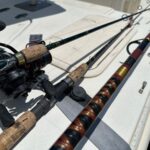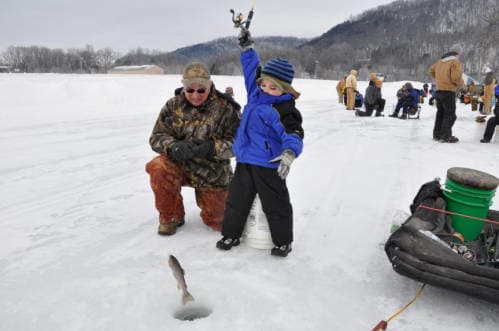
Below that layer of thick ice, lays an entire ecosystem thriving despite the frigid temperatures.
But, If you are new to ice fishing you may be wondering: what kind of fish do you catch ice fishing?
In this article, I’m going to tell you the most common species, and answer a few commonly asked questions so you can enjoy this wonderful hobby.
Let’s go!
This page contains affiliate links. As an Amazon Associate, I earn from qualifying purchases.
Table of Contents
What Kind Of Fish Do You Catch Ice Fishing?
The most popular fish species to catch while ice fishing include: Sunfish (Bluegill, Black Crappie, Redear Sunfish), Yellow Perch, Northern Pike, Walleye, Bass and Lake Trout. Other less common catches include Salmon, Burbot, Sauger, Whitefish and Catfish.
Below are a list of the most common and sought-after species you can catch while ice fishing. However, there are over 3,000 species of freshwater fish in North America, so you really never know!
Bluegill
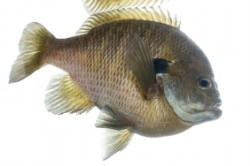
Probably the most recognizable and widespread of all the sunfish species is the Bluegill. Pound for pound they are excellent fighters, and great to eat as well.
Yellow Perch

The Yellow Perch might be the flagship ice fishing species. Primarily found in northern waters, these small but feisty fish are excellent to eat and a favorite among ice fishermen.
See Also: The Top 7 Best Yellow Perch Baits
Crappie
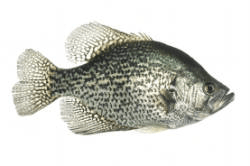
Although Black Crappie and White Crappie are often associated with warmer temperatures, don’t overlook them when the hard ice season starts. These fish are very good to eat, and grow up to 3 pounds!
See Also: Ice Fishing For Crappie, At Night!
Pike/Pickeral

Northern Pike are another flagship species for northern and cold temperature area (as the name implies). These fish grow very large, up to 50 pounds! They are excellent fighters and bite very well during the cold ice seasons.
Trout
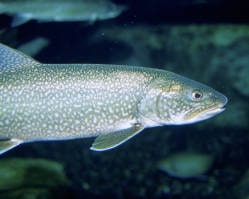
Trout are known as a cold-water fish, and there are multiple species you may catch while ice fishing. The more famous and sought after would be the Lake Trout, which can grow to a staggering 70-80 pounds.
Other common trout species under the ice include the Rainbow Trout, Brook Trout and Brown Trout.
See Also: How To Ice Fish For Trout
Walleye
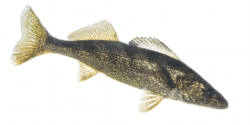
Walleye are another favorite among northern anglers. They pack the perfect combination of sizes. sporting quality and delicious taste.
They are sometimes confused with the Sauger– so always check your fish identification skills!
Bass
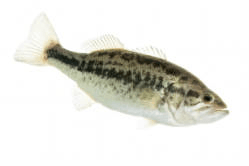
The immensely popular largemouth bass and smallmouth bass ring up a bit of controversy when ice fishing. These warm-water fish are prized by anglers and some feel they should not be targeted or brought up through the ice.
In any case, you may encounter them while ice fishing. Always be respectful of your catch and follow fishing regulations in your area.
Musky
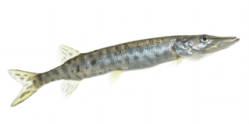
Musky, or Muskellunge are like the bigger & meaner brother of the Northern Pike. Capable of reaching enormous sizes with intimidating teeth, these are really a fish to behold.
Prized and admired by anglers- the Musky is a treat.
See Also: Musky vs Pike: 3 Easy Ways To Tell The Difference
Burbot
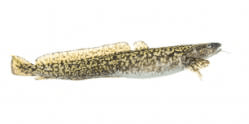
The Burbot is a fish that really does not look like any of the others we have mentioned. Mostly active at night these stealthy fish grow to 20 pounds and are a cult favorite among ice anglers.
See Also: Ice Fishing For Burbot
Salmon
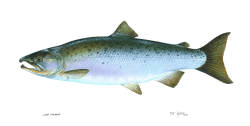
Many people associate with Salmon with gently flowing streams under the shadow of mountains and towering forests. But, there is a thriving and popular salmon ice fishery all around the world.
On lakes, land-locked Salmon are called ‘Kokanee’. In some areas, it is even possible to ice fish for salmon under the surface of frozen rivers and streams.
Sauger
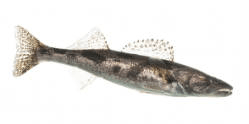
The Sauger is the second cousin to the Walleye, and although they look similar they inhabit different areas. These fish do not receive the praise of other similar species, but they offer good quality and often save the day.
Whitefish
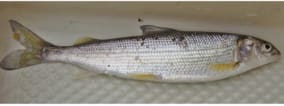
Whitefish or Mountain Whitefish are not typically found on the cover of fishing magazines, but don’t let that fool you. Hardcore ice anglers know that Whitefish are great for eating, and a ton of fun to target and catch.
Catfish
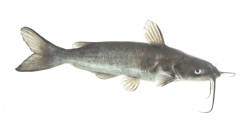
Catfish metabolism and activity slows down a lot during the cold winter months, but that doesn’t mean you can’t catch them! Channel cats are the most popular, but bullheads are known to bite as well. Fish slow, deep, and at night for your best chance at catching catfish.
What Do You Need To Ice Fish?
Must Have Items
If you are interested in learning how to ice fish, there are a few must-haves or essential items. I’ll break down each one here:
Rod and Reel
To catch fish you need a rod and a reel. Now, there are tons of different types of fishing reels and rods on the market today, but don’t let that overwhelm you.
Most ice fishing reels are fairly small in size. Usually, they are in the 500-2500 size range and spooled with 2-8 lb test line.
The rods are usually very short because unlike conventional fishing you are not doing any casting, therefore you don’t need a long rod.
Instead, you are fishing vertically, straight up and down into an ice hole. This means that ice fish rods are usually very short and maneuverable.
The Whiteout Combo by 13 Fishing is a great beginner ice fishing rod & reel combo

Bait or Lures
The next thing that is essential to ice fishing is either bait (live or dead) or lures. You have to entice the fish to bite with something!
Stop by your local bait and tackle shop and chat with them about bait and lure suggestions for your area. They should be able to point you in the right direction.
As a general rule of thumb, smaller baits and lures are most effective when ice fishing because fish can be sluggish and reluctant to bite.
Blade baits, micro jigs, mini-spoons, and small swimbaits are popular options. And you can never go wrong with live bait like Nightcrawlers on a small #4 Aberdeen hook.
See Also: 12 Tackle Box Essentials For All Anglers
Ice Auger
In order to fish under the ice, you need to drill a hole. To do this most people use an Ice-Auger. It’s like a giant drill bit that cuts into the ice and creates a small opening for you to fish.
There are all sorts of Augers, from gas, electric, and even drill attachments. But I think the most simple is a hand auger.
This 5-inch hand Auger by Strikemaster is very popular and does a great job at an affordable price

Warm Clothing
If your ice fishing, well, let’s face it- it’s gonna be cold! In order to maximize your time on the ice and stay safe, it’s important you dress warm.
Dress in layers, preferably in fabrics that wick away moisture such as wool. Insulated bibs and water-resistant jackets are popular. Footwear should be waterproof and have adequate grip to prevent slipping on ice, and gloves and hats are a must.
Remember- it’s much easier to peel off a layer of clothing if you get too hot, but you cant add clothing if you don’t bring it with you.
Check the weather forecast, and plan accordingly. Ice fishing can be a ton of fun, but not if you are freezing on the ice!
Optional Items
Now, with any hobby, there are all sorts of bells and whistles. Ice fishing is no different. There are must-have items, and then there are optional or nice-to-have items.
Below is a list of optional items that may increase your chances of success or provide comfort- but remember, they are not required to get started!
Fish Flasher or Sonar
You’ve probably heard about fish finders or sonar units mounted on boats (such as the immensely popular Garmin Livescope). They send a signal down into the water and bounce back information to the screen indicating what’s below the surface.
Well, you can get fish finders or ‘flashers’ for ice fishing. These units set up on top of the ice and have a wire unit you lower into your ice hole.
They can be VERY effective, and actually ‘flash’ on the screen when a fish swims below your hole.

They’re very popular in the ice-angling community and start at around $249.
Ice Shelter
Another nice to have item (but not required) is an ice shelter or ice hut. These are basically portable tents or blinds you set up over your ice hole.

They protect you from harsh winds and rain, and provide a space to fish and relax and even heat up with a portable heater.
If you’ve ever driven by a frozen lake and see a lot of these ice huts- you know it’s good fishing!
Heater
Portable Heaters are inexpensive ways to heat up an ice hut, or your hands and feet while fishing. Sometimes you may have to take off the gloves to handle a fish or bait a hook, and having a portable heater nearby feels amazing.

Tip-ups
Ice fishing Tip-ups are a piece of fishing equipment that suspends bait down in the water and provides a visual indicator when a fish is biting.
They are great for fishing multiple ice holes, prospecting locations, and targeting schools of delicious panfish.
This article by MeatEater does a great job of explaining how to fish with a tip-up.
Ice Fishing Safety- Very Important!
Check Ice Thickness
Always check the thickness of the ice before attempting any travel or fishing. Popular ice fishing lakes will often post the ice fishing thickness at boat ramps and advise if it’s unsafe.
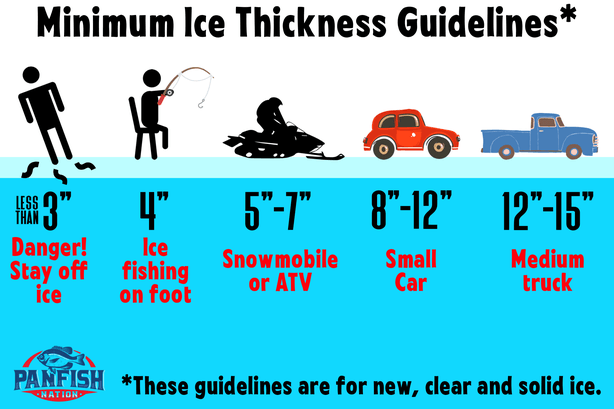
You can also contact your local DNR or fisheries agency, or local bait and tackle shops to find out the ice thickness in your area. Talk with other anglers and look online.
As a general rule of thumb, new ice (solid and clear) must be at least 4 inches thick to support ice fishing on foot.
Once you get a report of the ice thickness, always confirm every few steps. Use an ice pole pick, spud bar, or your auger to test the ice thickness.
Some areas of the lake may be thicker or thinner than others; always proceed with caution.
Dress Appropriately
As I mentioned previously, you want to always dress appropriately for ice fishing. Not only are you fishing on top of a giant ice cube, but your often exposed to wind on open lakes and bays.
Gloves, hats, and waterproof non-skid boots are very important. Dress in layers and avoid working up a sweat. Thick insulated outer layers are best for trapping in body heat.
Bring Safety Equipment
It’s always a good idea to have safety equipment on hand while ice fishing. This should include a life jacket, 100 feet of safety rope, ice picks, and a handheld VHF radio or cellphone. A ruler or tape measure is important for getting an accurate measure of ice thickness.
Tell a Friend or Family
As with any endeavor into the great outdoors, always tell a friend or family of your plans. Let them know the exact name and location you will be fishing. Inform them of when you are leaving, and when you intend to return home.
I always tell my family when and where I’m going, anytime I’m going fishing.
Click Here For More Ice Fishing Safety Tips & Best Practices
Common Questions About Ice Fishing
What reel should I use for ice fishing?
Spinning reels are the most popular reels to use for ice fishing, but other options include baitcasters and special in-line reels designed to prevent line twist.
See Also: Ice Fishing Reel vs Regular Reel, What’s The Difference?
What is the best bait for ice fishing?
The most popular live baits for ice fishing are minnows, wax worms, leeches, nightcrawlers, spikes, and red wigglers. Popular artificial baits for ice fishing include small jigheads, jigging spoons, swimbaits, and soft baits.
Each species of fish has a ‘favorite’ bait, and there may even be a preferred bait or lure to your local area or region. Experiment with different baits and lures, and try lure/bait combinations.
For example, many anglers tip their jigs with wax worms or larvae and use a hybrid approach when ice fishing.
What time of day is best for ice fishing?
Sunrise and sunset are the best times for ice fishing. Plankton, larvae, and baitfish are all active as the sun rises and sets, which causes predatory fish to feed and move.
However, plenty of anglers prefer to fish long after sunset and night fish on the ice, especially in heated ice tents or huts.
How do you pick a good ice fishing spot?
The key to picking a good ice fishing spot is by learning about the body of water you are fishing. If possible, try scouting the water during the warmer months so you can learn its depth, contours, and structure.
Mark areas like flats, points, weed beds, rock piles, and stump fields. Keep a log or journal of where you catch certain fish species and use that information in the winter.
During the winter months, drill multiple holes and try different methods and baits. Try fishing some holes deep, and others shallow.
You will begin to notice a pattern and double down on the methods and areas that produce.
Talk to other anglers, network, and conduct research. You will be surprised at what fellow anglers are willing to share!
See Also: How To Find Fishing Spots Near Me (You!)
What depth should I ice fish?
The depth you should ice fish is directly related to the type of fish you are targeting. For example, fish like Lake Trout and Salmon are often targeted deep, in 20 feet or more. Other fish like Pike and Walleye are often shallow, in that 6-12 foot range.
Do I need a special line for ice fishing?
Although you can buy special fishing line rated for ice fishing, many anglers opt to use monofilament or fluorocarbon fishing lines. These are usually a little less expensive, and unless you are fishing in extremely cold temperatures should perform the same.
Can I use regular braid for ice fishing?
Braided and Dacron lines are not recommended for ice fishing because they can actually freeze or stiffen up in the cold water. Instead, use a monofilament or fluorocarbon line rated for ice fishing and handling cold temperatures.
Does weather affect ice fishing?
Even though the weather may be taking place above the ice, it does have an effect on fishing and activity below the surface. Changes in barometric pressure, sunlight, and wind all influence fishing activity even in the dead of winter.
See Also: Fishing After The Rain, Is It Worth It?
If you haven’t guessed yet, I love fishing and everything about it!
To learn more about why I started Panfish Nation, visit the About page and follow along on Social Media:


Download a copy of my FREE Lure Color Selection Chart & Knot Guide!
Stay up to date with fishing reports, tackle reviews, industry news, and much more! We respect your privacy, unsubscribe at any time.
- Crazy Facts About the World Record Crappie

- What Size Hooks for Smallmouth Bass? Quick Guide

- Large and in Charge-Mouth: 10 of the Best Bass Lures of All Time (And Where to Buy Them)

- Emperor of the Sun(fish): What You Need to Know About the World Record Bluegill
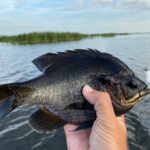
- The Seven Best Lures for Fall Bass Fishing
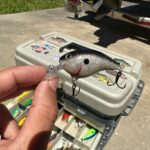
- Which Fishing Line is Best for Bass Fishing With A Spinning Reel?
